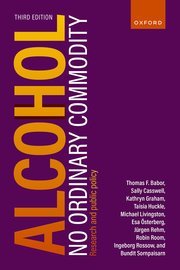In the third edition of Alcohol: No Ordinary Commodity, a group of esteemed researchers analyse the global burden of alcohol-related disease, the economic and political power of the alcohol industry, and the scientific basis for alcohol policy. The following edited excerpt sets the stage for the book by discussing the dual role of alcohol as a drug and a commodity.
Alcohol is a psychoactive substance that has been used since antiquity as a dietary supplement, social lubricant, and intoxicant. Beer, wine, and distilled spirits are also commodities that are bought and sold in the marketplace. And alcohol is a drug with toxic effects that cause physical, social, and psychological harm. In recent years, public discussion of alcohol policies has too often ignored or downplayed the need to understand the nature of the agent, its social and psychological functions, and its harmful properties.
The cultural, social, and symbolic meanings of alcohol
The history of alcoholic beverages shows that drinking has served many purposes for the individual and society. As Heath (1984) noted, alcohol can be at the same time a food, a drug, and a highly elaborated cultural artefact with important symbolic meanings. In contemporary societies, alcohol products are mainly used as beverages to serve with meals, as thirst quenchers, as a means of socialization and enjoyment, as instruments of hospitality, and as intoxicants.
In earlier times, alcoholic beverages were frequently used as medicine (Edwards, 2000). Alcohol preparations are still listed in ‘essential medicine’ lists, in that they are regarded as essential and inexpensive for use as disinfectants and other (non-drinking) applications in medical environments (World Health Organization, 2019).
Until the advent of clean water supplies in Europe and America in the late nineteenth century, alcoholic beverages were considered to be a healthy alternative to polluted drinking water (Mäkelä, 1983).
Alcoholic beverages are used in many cultures in a variety of social situations, both public and private (Heath and Glasser, 2003). They are frequently used to commemorate births, baptisms, and weddings. In a religious context, the consumption of alcohol may be limited by ritual expectations, as in the Catholic mass and the Jewish Seder, where only very light drinking is condoned.
In some communities, the provision of an abundance of alcohol in social situations is almost mandatory, and is seen as a sign of wealth and power by those who provide it.
Throughout the life cycle from youth to old age, it is associated with many positive aspects of life. It is used in traditional social rituals in many places. In some social situations, even intoxication is seen as an acceptable and pleasurable pursuit.
Buying and selling alcohol
Alcoholic beverages are produced and distributed in four ways (Room et al., 2002). First, there is home brewing and craft production of both distilled spirits and traditional fermented beverages (Lachenmeier et al., 2021). Second, there is industrial production and distribution of commercial versions of these indigenous beverages such as chibuku in southern Africa, soju in South Korea, and pulque in Mexico. Third, there is local industrial production of ‘international’ beverages such as domestic whiskey in India and lager beer like Corona in Mexico. Fourth, there is production of branded international beverages, which are increasingly marketed on a global scale.
In many countries, the production and sale of alcoholic beverages are an important economic activity. They generate profits for producers, advertisers, and investors. They provide employment opportunities for wholesalers and retailers, bring in foreign currency from exported beverages, and generate tax revenues for the government. Alcohol is a major source of sales and profits for the travel and hospitality industries, including hotels and restaurants. For these reasons, there are many vested interests that support the continuation and growth of alcohol production and sales.
Consumer spending on alcoholic beverages usually generates tax revenues, which make these products a popular source of income for local, state, and national governments. But alcohol also imposes economic costs on society, including healthcare, policing (plus courts and prisons), crime prevention, property damage, traffic accident damage, workplace unproductivity, unemployment, and premature mortality. Public health responses need to reflect an improved understanding of the nature of an agent that is far from being an ordinary kind of commodity.
This text was extracted from the third edition of “Alcohol: No Ordinary Commodity”, and edited for the SSA website by Natalie Davies.
Alcohol: No Ordinary Commodity was published by Oxford University Press in 2023, with the support of the International Confederation of Alcohol, Tobacco and other Drug (ATOD) Research Associations (ICARA) and the Society for the Study of Addiction (SSA). It was authored by Thomas F. Babor, Sally Casswell, Kathryn Graham, Taisia Huckle, Michael Livingston, Esa Österberg, Jürgen Rehm, Robin Room, Ingeborg Rossow, and Bundit Sornpaisarn.
The book is available to purchase in paper and e-book form. All royalties from book sales will be donated to the Society for the Study of Addiction in order to finance translations into other languages as well as other dissemination activities.
The journal Addiction also published a narrative summary of the contents of the book, which is free to read in the Wiley Online Library.
The opinions expressed in this post reflect the views of the author(s) and do not necessarily represent the opinions or official positions of the SSA.
The SSA does not endorse or guarantee the accuracy of the information in external sources or links and accepts no responsibility or liability for any consequences arising from the use of such information.


